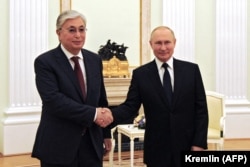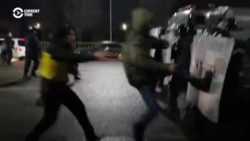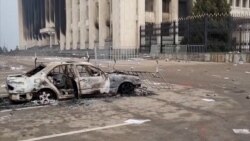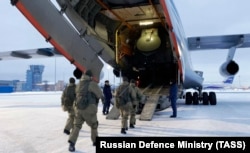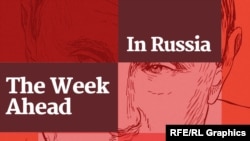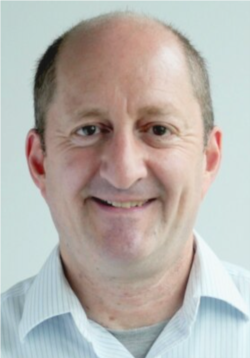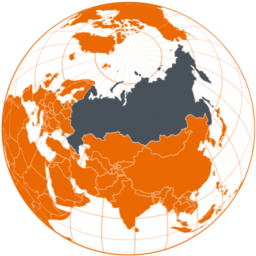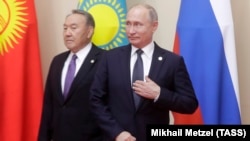
What does the Kremlin want out of Kazakhstan, why did it send troops -- and how will the upheaval in the neighboring nation affect developments in Russia itself for years to come?
Here are some of the key developments in Russia over the past week and some of the takeaways going forward.
About Face
In 2010, when a Moscow-dominated military alliance was asked to send troops to quell violence in Kyrgyzstan, it declined.
Dmitry Medvedev, the Russian president at the time, said that for the Collective Security Treaty Organization (CSTO), a mission like that is justified only by "violations by a state or nonstate entity of a CSTO member state’s borders. In other words, an attempt to seize power from the outside."
Over a decade later, it took the CSTO just a few hours to respond to a similar request from Kazakhstan’s embattled president -- in the affirmative. And hours after that, troops from Russia and other members of the six-country CSTO were on their way to the Central Asian country that was abruptly wracked this week by widespread popular protests and a violent police response.
It was the first time the CSTO has ever sent troops into a member state for anything more than exercises, parades, and the like.
The CSTO has held joint exercises and cooperated in counternarcotics efforts, but the deployment of troops to Kazakhstan is a first.
What changed?
Officially, the situation in Kazakhstan is different from the situation in neighboring Kyrgyzstan in 2010: After initially calling protesters “hooligan elements,” President Qasym-Zhomart Toqaev later claimed that the country was under attack by "terrorists"” who "received extensive training abroad."
He provided no evidence of the alleged training or any other foreign involvement in the protests, which were sparked by anger over vehicle-gas prices and were rooted in desperation over economic conditions for the majority in the energy-rich country and concerns about corruption among members of the elite.
Russian officials soon echoed the theme of interference from abroad. On January 5, President Vladimir Putin’s spokesman said Moscow was confident that the Kazakh authorities could handle the situation themselves. On January 5 -- after statues of longtime former President Nursultan Nazarbaev were toppled and crowds stormed several government buildings -- the Russian Foreign Ministry framed the events in Kazakhstan as “an attempt, inspired from the outside, to undermine the security and integrity of the state by force.”
Given the lack of evidence of outside involvement, however, that narrative sounded like a pretext to many people who study Russia, Kazakhstan, or both.
So, what are Russia’s real motives?
The simplest answer is that Putin -- surprised by the sudden upheaval in Kazakhstan, a vast fellow former Soviet republic that shares a long border with Russia and has close, warm ties with Moscow despite tensions bubbling beneath the surface – wanted to try to avert any major political change there.
Maybe so. It’s hard to imagine that Putin, who is mindful of popular anger against authoritarian leaders, and whose attention lately seems laser-focused on a mounting confrontation with Ukraine and NATO that is mostly of his own making, welcomed the news that protests were sweeping Kazakhstan.
Drinking Shampanskoye?
Toqaev’s request for CSTO intervention was “bad news for Moscow,” R.Politik, a think tank headed by analyst Tatyana Stanovaya, wrote on Telegram. It “puts Russia in a highly uncomfortable position, being pulled into an internal conflict where it would not like to fall foul [of] any of the involved conflicting sides.”
Once the toothpaste was out of the tube, though, Putin may have decided to try to make the most of it: not just avert a loss of influence in Kazakhstan but use the situation to attempt to increase Moscow’s sway in the country of 19.2 million, which is the ninth-largest in the world by area and is a key ally in the CSTO and Eurasian Economic Union, a regional customs bloc widely seen as Putin’s attempt to mirror the EU.
“Russia was presented [with] a sudden crisis that it now seeks to turn into an opportunity,” Maksim Suchkov, director of the MGIMO Institute for International Studies in Moscow, which provides policy analysis to the Russian Foreign Ministry, wrote on Twitter on January 6.
“Moscow has a chance to take the most advantageous position for itself -- a physically forceful presence on the territory of a state that is crucial for Russia in the role of a guarantor upon whose position further events depend,” Fyodor Lukyanov, chairman of the Council on Foreign and Defense Policy, a think tank with close ties to the Kremlin and the government, wrote in a January 6 article.
For Russia, the “ideal situation” when it comes to countries of interest is to install a “power fuse” that “makes it possible not to worry too much about the internal political dynamics there,” Lukyanov wrote. “In other words, it doesn't matter who gets the upper hand, because any government will have to take into account the objective circumstances -- the Russian military presence.”
The events unfolding in Kazakhstan come amid a major effort by Moscow to gain influence over Ukraine and even the rest of Eastern and Central Europe, in part by keeping those that are not NATO members out of the alliance and limiting military deployments and cooperation across the region. At the same time, Russia has increased its sway over Belarus by propping up autocrat Alyaksandr Lukashenka amid massive protests following a 2020 election many say he stole.
The Kremlin may see the situation as an opportunity to rope Kazakhstan -- which has maintained a distance from Russia despite the close ties by pushing back against efforts to make the Eurasian Economic Union more of a political alliance, among other things -- even closer into Moscow’s orbit.
“I wouldn’t be surprised if some strategists in Moscow are already ‘drinking champagne’ thinking that Russia will soon secure full loyalty of [Toqaev] and his team with relatively cheap intervention. In and out in a few weeks,” Anton Barbashin, editorial director at the media outlet Riddle Russia, tweeted on January 6.
Maybe hold off a bit on popping those corks, though.
With decades of Soviet-era domination by Moscow as a backdrop, Russia’s aggression against Ukraine since 2014 has heightened concerns about its intentions across the former U.S.S.R. In Kazakhstan, hints of possible Russian designs on the country's largely Russian-speaking northern reaches are a particular worry.
Putin has stoked concerns with a series of provocative comments that appear mostly aimed at Ukraine but have raised hackles elsewhere as well, such as his reference to the collapse of the Soviet Union as “the disintegration of historical Russia."
So, sending in troops is a risk, and the reception Russia gets may depend in part on whether their role is limited to guarding key facilities or branches out into crowd control or other activities that might pit them directly against opponents of the authorities.
“Kazakhstan is another test, after Belarus, of [Russia’s] ability to help stabilize its formal allies [without] alienating their populations,” Dmitry Trenin, director of the Carnegie Moscow Center, wrote on Twitter on January 6.
“Lots of potential pitfalls around, but [it could be a] big boon if Moscow succeeds,” Trenin added.
Beyond Kazakhstan, a CSTO deployment that goes relatively well could help bolster Russia’s reputation among fellow members of the alliance, while also sending a signal that Russia is ready to intervene -- or withhold intervention, if it chooses -- when those governments get into trouble.
Failure or the use of excessive force, however, could increase the concerns in those countries about Russia’s intentions, potentially pushing away both their leaders and their citizens and making Moscow’s efforts to maintain or increase its influence more difficult.
“I won’t venture to guess what [Kazakhs] will think about the Russian military presence,” Arkady Dubnov, a Russian expert on Central Asia, told the Internet channel TV Rain (Dozhd). “It’s too risky.”
The assigned task of the troops may be merely to guard facilities, but “that was the assigned task of the [Soviet] military contingent in Afghanistan during its first weeks there,” Dubnov said, referring to what developed into the devastating 1979-88 war of occupation.
President For Life?
Meanwhile, the unrest in Kazakhstan could have major repercussions inside Russia as well -- in 2022, in 2024, and beyond.
A conclusion swiftly drawn by several observers was that it will make any let-up in the state clampdown targeting Kremlin opponents, civil society, independent media, and dissent in general even less likely in 2022 than it already was. Not that a let-up was expected in the first place.
“One thing is clear -- there will be yet another crackdown in Russia” as a result of the events in Kazakhstan, Barbashin wrote on January 5.
Numerous analysts said the developments in Kazakhstan would also make Putin more likely -- or again, even more likely than he already was -- to run for reelection in the next presidential vote, due in March 2024.
Why? To spare himself from the fate of Nazarbaev, the long-ruling Kazakh leader who stepped down from the presidency in 2019 – and now may be out of top echelons of power for good.
In 2019, at the age of 78, Nazarbaev announced he was resigning as president but staying on as chairman of the ruling party and the powerful Security Council -- as well as retaining his status as “elbasy,” a title that translates as Leader of the Nation and came with lifetime immunity for himself and his family.
Nazarbaev’s move was watched closely by Russia-watchers -- and presumably by Putin, who at the time faced a bar on reelection in 2024, due to a limit of two consecutive terms -- and appeared to be considering a number of potential ways to keep a hold on power once out of the presidency.
One of the possible pathways that was frequently cited was a role as the head of the State Council -- a mostly ceremonial body that, if given more clout, was seen as a way for Putin to maintain power while handing off much of the responsibility of the president to a trusted successor.
The spotlight on that option faded in 2020, when Putin pushed through a constitutional amendment that freed him up to run again in 2024 -- and 2030 -- if he wishes. Toqaev’s dismissal of Nazarbaev as Security Council chief, and the protesters’ focus on elbasy as the man representing and responsible for the inequities in Kazakhstan -- may make it even more likely that Putin will try to stack the odds against such a development by staying on as president.
The “Kazakh events make [the] Kazakhstan power transit scenario virtually impossible for Russia,” Aleksandr Baunov, a senior fellow at the Carnegie Moscow Center, wrote on Twitter on January 5. “Now Putin will hardly be inclined to leave his position to a successor and watch over him as a head of National Security Council or some other government body.”
Pavel Lokshin, Moscow correspondent for the German media outlet Welt, put it more simply. In a tweet displaying photos of a statue of Nazarbaev that had been torn down and cut in half, the torso and head lying face up on the cobblestones, he wrote: “Bad news, Putin is never going to retire.”
NOTE: The Week In Russia will not appear next week. It will return on January 21.





